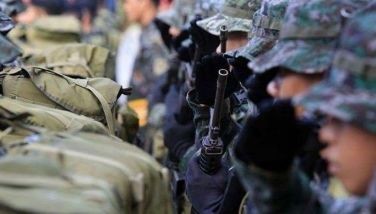RP revives nuke program
The Philippine government has officially restarted its nuclear energy development program after it entered into a memorandum of understanding (MOU) with the Korean government for a feasibility study on the possible revival of the mothballed Bataan Nuclear Power Plant (BNPP).
In a statement, the National Power Corp. said it had signed the MOU with Korea Electric and Power Co. (KEPCO) last Nov. 25 in Cebu City.
KEPCO, according to Napocor, is the best partner for this undertaking, as it is well known for its nuclear projects.
The state-run power generation firm added that the nuclear reactor in the BNPP has a “twin sister” in South Korea, the 650-MW Kori 2, commissioned in 1983 and which has been operating since then.
“It is also expressly understood that the signing of the MOU does not give KEPCO any preferential right to future projects or plans that Napocor may undertake on the BNPP. It is clearly understood between Napocor and KEPCO that nothing in the MOU shall be construed as a commitment by the National Power to KEPCO to rehabilitate the BNPP, and that the MOU is non-exclusive,” it said.
Napocor president Froilan Tampinco and KEPCO Philippines president Kang Won Lee signed the MOU, which will be valid for three years.
The agreement will “promote bilateral cooperation in the fields of nuclear power plant operation, maintenance and rehabilitation through the exchange of data and experience, visits and joint work.”
Both parties expect to benefit from “sharing invaluable experience and knowledge to be gained from such cooperation.”
The MOU also covers the exchange of data; activities related to determine the feasibility of the rehabilitation of BNPP; exchange of visits by experts, engineers and technicians in nuclear power generation; and cooperation in nuclear power plant rehabilitation, operation and maintenance and other related business fields.
Based on the agreement, Napocor and KEPCO will conduct various studies, such as those for preparation, planning and implementation of the cooperation project; site survey for the project, subject to the safety and security regulations of Napocor; nuclear legislation, regulation and administration; studies on environmental impact of the project; human resources development related to the project.
Other subjects of mutual interest, as may be agreed upon by both Napocor and KEPCO, are also expected to be pursued.
KEPCO has been signifying keen interest to assist the Philippine government in this endeavor for several years.
Currently, Kepco runs 20 nuclear power plants in operation and 15 under construction. Nuclear power contributes a majority of Kepco’s power generation mix.
Early this year, the Philippine government tapped a team from the International Atomic Energy Agency (IAEA) to study a plan to use nuclear energy as a source of power.
Based on the Philippine Energy Plan (PEP), it was projected that a 600-megawatt (MW) nuclear power plant will be built by 2025. This will contribute 0.885 million-ton oil equivalent (MTOE) to the projected energy mix and will reach up to 3.54 MTOE by 2035.
Under the PEP 1998-2035, total capacity from nuclear will reach 2,400 MW by the end of the planning period.
The first nuclear power facility in the country, Philippine Nuclear Power-1 (BNPP), was supposed to operate commercially in 1986, but it was mothballed due to vehement opposition from environmental and cause-oriented groups.
- Latest
- Trending






























